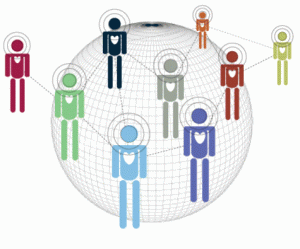Church v.2020 – Ten Changes:
#4 More Connected – Less Geographically Dependent
When compared with the American church of 2012, the future church (v.2020) will be more connected and less geographically dependent. The increased abilities of technology along with increased utilization within the church will facilitate many changes, including:
 Most congregations will move from being identified primarily by a physical presence (e.g., church campus that includes one or more buildings) to a hybrid presence that blends the existing physical presence with a virtual presence. Regardless of size, churches will evolve to include virtual aspects that complement those that were historically found exclusively on the church campus (or in other spaces where people gathered physically). While smaller parishes may do most things either on campus or online, larger congregations will do this for certain opportunities while making many worship services and discipleship/followership activities available simultaneously to those on and off campus (allowing both groups to interact with one another).
Most congregations will move from being identified primarily by a physical presence (e.g., church campus that includes one or more buildings) to a hybrid presence that blends the existing physical presence with a virtual presence. Regardless of size, churches will evolve to include virtual aspects that complement those that were historically found exclusively on the church campus (or in other spaces where people gathered physically). While smaller parishes may do most things either on campus or online, larger congregations will do this for certain opportunities while making many worship services and discipleship/followership activities available simultaneously to those on and off campus (allowing both groups to interact with one another).- Most congregations that average over 100 in worship each week (and a lesser number of smaller congregations) will intentionally, creatively, and contextually leverage a blend of web 1.0, 2.0. and 3.0 tools to further define and further develop congregational DNA. Additionally, these congregations will facilitate connectedness in both the physical and virtual spaces they inhabit.
- An increasing percentage of new church developments (church launches/plants) will occur online and will not be dependent on attracting people in the same geographic community. In this sense these “local churches” will be communities that are really together with such bonds occurring exclusively or primarily in virtual manners.
- An increasing percentage of large congregations will have “internet campuses” or other robust offerings that include worship services (designed for the virtual world, not simply sharing services held on the physical campus online). These offerings will be targeted toward reaching new people and allowing existing adherents to remain connected when unable to attend physically due to travel and/or work scheduling conflicts.
So What?
In many ways this new model decentralizes the local church creating a more scalable (more on the shift toward a more scalable church was discussed in the #8 change needed for the church of the future) and egalitarian (more on the shift toward a more egalitarian church will be discussed in the #2 change needed for the church of the future) community. In this sense it provides an incredible diversity of strategic possibilities.
- Compared to businesses in your local community of similar sizes, how would you characterize your congregation’s current efforts to leverage technology for its on campus and online ministries? Which of the following terms most closely reflects your parish in this regard: innovator, early adopter, early majority, late majority, or laggard?
- List all of your congregation’s many activities (worship, fellowship, education, etc.). For each item evaluate whether the opportunity was offered on campus or online or both for the following three calendar years: 2004, 2012, and 2020 (projected). Ask another member of your congregation to engage in the same activity then discuss your results.